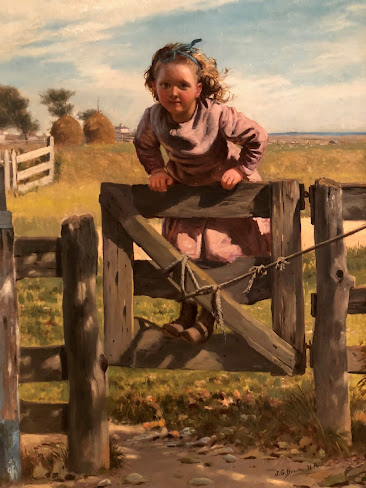Ever looked at a 19th-century painting and thought, “Now that’s a kid who’s about three seconds from breaking a collarbone”?
Enter John George Brown’s Swinging on the Gate, a visual poem to childhood mischief, countryside charm, and the kind of rural OSHA violations only nostalgia can make cute. A young girl, somewhere between “adorable” and “menace,” balances on a creaky wooden gate with the poise of a gymnast and the grin of someone who knows the adults aren’t looking. Spoiler: They probably are. They just gave up.
This isn’t just a painting. It’s a time capsule of an America that wanted to pretend it was all haystacks and sunshine while ignoring the rising smoke of industrialization, urban poverty, and a generation of kids who worked real jobs before they lost their baby teeth.
But Brown, ever the sentimentalist with a brush, gave us a world scrubbed clean of soot and sweat. Born in Durham, England in 1831 and shipped over to New York like a Dickensian orphan, Brown made it. He went from glasscutter to America’s unofficial Minister of Moppets, painting street urchins, flower girls, and bootblacks with the kind of adoration usually reserved for cherubs and show ponies.
In Swinging on the Gate, he trades the grimy cobblestones of the city for the pastoral dream of rural innocence. But don’t be fooled. That little girl isn’t just swinging—she’s testing boundaries. She’s the frontier spirit incarnate: grinning, fearless, ready to leap into trouble, consequences be damned.
This was painted in the late 19th century, when Americans were nursing a collective hangover from the Civil War and binge-watching Manifest Destiny. Brown gave the public what they wanted: pictures of scrappy kids with bright eyes and clean fingernails. It was comfort food for the soul—warm, simple, familiar. Paintings like this one sold like lemonade at a revival meeting, and lithographs of Brown’s work were the 19th-century version of going viral.
But behind the sweetness is a subtle rebellion. That kid isn’t posing. She’s owning the fence. She’s saying, “I know the rules. I’m choosing not to care.”
At its core, Swinging on the Gate is a love letter to unsupervised childhood, a now-endangered species. It’s about defiance wrapped in innocence, and maybe, just maybe, a reminder that sometimes the most meaningful art doesn’t preach—it plays.
When was the last time you broke the rules just to feel the wind in your hair—and would you do it again even if the gate splinters?
#JohnGeorgeBrown #AmericanArt #ArtHistory #19thCenturyArt #OilPainting #FineArt #Realism #GenrePainting #ClassicArt #MuseumArt #ArtLovers





No comments:
Post a Comment